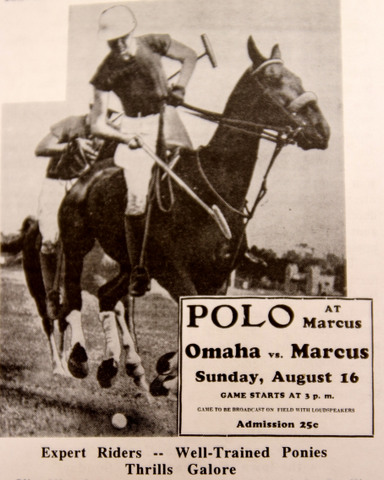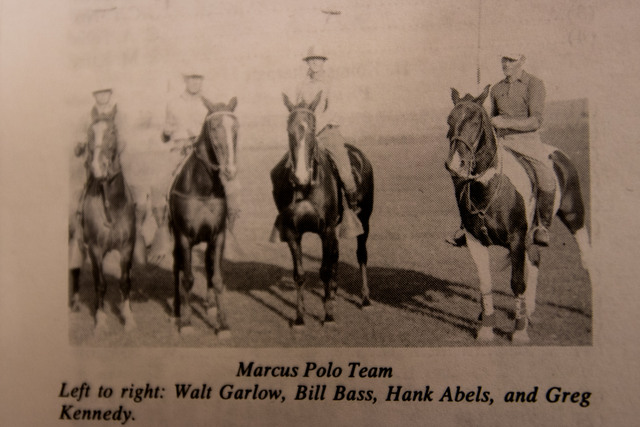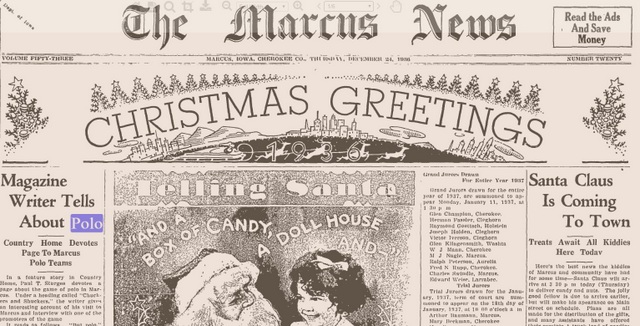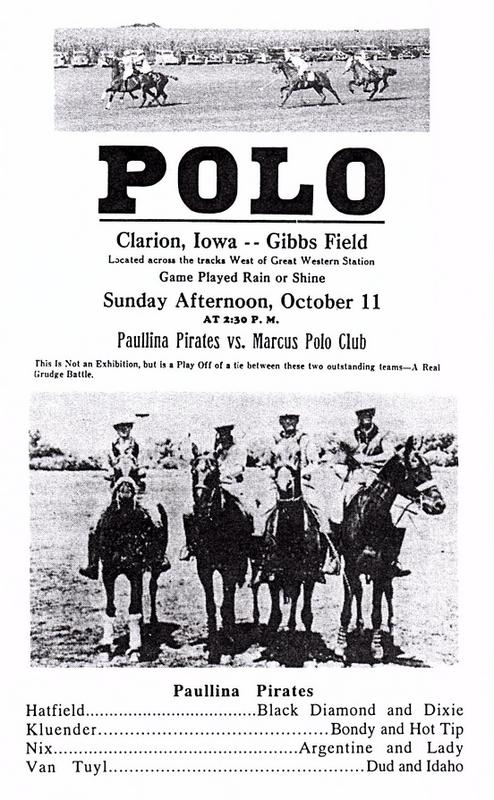
Small – Town Iowa Polo Teams Thrilled Depression – Era Crowd
What comes to mind when you think of polo? English royalty, perhaps, since this ancient, unique blending of athletic talents between horse and rider helped polo become the “sport of kings.”
Yet there was a time in northwest Iowa when polo reigned as the sport of the common people. It happened in an era when rural Iowans desperately needed a diversion, if only for a Sunday afternoon, from life’s harsh realities.
It all started in the early 1930s in the small Cherokee County town of Marcus. I first heard about this intriguing tidbit of local history from Beth Kingdon, director of the Marcus Public Library, when I shared my “Culinary History of Iowa” program at the library. “Since you like Iowa history, you might be interested in this,” said Beth, as she opened the 700+-page book “Pride in the Past Faith in the Future: A Historical View of Marcus, Iowa.”
Sure enough, right there on pages 157-158 a section titled “Marcus Polo Team” spun a long-forgotten tale of rural Iowa. “The Marcus Polo Team made history in the 1930s for the small but prosperous farm community, providing thrilling Sunday entertainment for residents far and near,” stated the article.
No doubt there were thrills galore, since there’s nothing subtle about polo. This is in-your-face, aggressive horsemanship at its best, demanding power, intense speed, balance, coordination, quick reflexes, strategy, well-trained horses and expert riders.
 “Shucking corn develops a wrist, and that’s what polo takes”
“Shucking corn develops a wrist, and that’s what polo takes”
The Marcus team consisted of local businessmen and farmers, including Gregory Kennedy, Kenneth (Kim) Bancroft, W.W. (Bill) Bass, Henry (Hank) Abels, Walter Garlow and Glenwood French (the alternate). The Marcus Polo Club boasted a “splendid field” just a mile and a half south of town, where polo matches were played on the W.E. Wiley farm (managed by Walt Garlow). “Two Marcus youths, Jimmy Hogue and Roy (Junior) Williams, were full-time groomsmen for Kennedy and Garlow,” the history noted.
Polo was introduced in Marcus around 1931. By the early to mid-1930s, there were polo teams and/or polo fields in Paullina, Primghar, Clarion, Sheldon, Spencer and beyond, including the famous Barnes Bros. polo team from the Cherokee/Peterson area.
The Marcus Polo Club gained a strong reputation by beating professional teams from Minnesota to Omaha and clinched the Iowa championship by defeating the Des Moines team at the Iowa State Fair. The Marcus Polo Club eventually expanded into two teams, the Purple Team and the Orange Team, which traveled as far away as Sioux City and Pierre, South Dakota, to compete.
The famed Marcus team even caught the media’s attention. In 1936, Country Home magazine devoted a page-long article to document this fascinating phenomenon on the Iowa prairie. Here’s a snippet from Paul T. Sturges’ feature story:
“But polo,” I objected. “Isn’t that a millionaire’s game?
“Practically everyone seems to think so,” said Kenneth Bancroft. “But around here, most of our players are farmers.”
We were talking in Bancroft’s meat market in Marcus. On the wall, pictures of sleek polo ponies flashed white-helmeted riders, a team as proud as the best of them.
“No, don’t get the idea polo is just a rich man’s game,” continued Bancroft.
“Bill Ginger started us going. We used farm horses for mounts. Bill lives up a Gaza, Iowa. He’s farming. Had played polo in the Black Hills, enough at least to get polo in his blood.”
 To make a polo mallet, Bill unearthed an old binder roller, sawed out a chunk, drilled a hole into it, and inserted a lengthy of hickory wood into this homemade affair. “First thing they know, people saw Bill out in his pasture on horseback larruping a ball around,” Bancroft said.
To make a polo mallet, Bill unearthed an old binder roller, sawed out a chunk, drilled a hole into it, and inserted a lengthy of hickory wood into this homemade affair. “First thing they know, people saw Bill out in his pasture on horseback larruping a ball around,” Bancroft said.
Joe Hey, the harness maker, braided whang leather loops on the mallets’ handles. A local pasture provided the playing field, and it was game on. “On stock saddles cinched to regular farm horses, the boys, when the farm work was done, would make for the pasture and have a barrel of fun. The players lined up in center field. The umpire throws the ball out, and it’s in play until it crosses the goal.”
Those Iowa farmers knew their style of polo was a bit—unique. “If today’s crack polo players could have seen us then, they would have died laughing,” Bancroft said. “Imagine horses weighing 1,800 pounds galloping after a little ball.”
The rural Iowa polo players’ gear made the game affordable, from homemade mallets to second-hand Army saddles. “It was inexpensive,” Bancroft noted. “The town boys boarded their ponies with the farmers, who, in turn, found the extra horses came in handy during cultivating time. Corn-shucking time, our players would use their horses on the wagon and then in the evenings would throw on saddles for a whirl at polo. Shucking corn develops a wrist, and that’s what polo takes.”
Chukkers and shuckers
The talented Marcus Polo Club beat professional teams from Minnesota to Omaha and clinched the Iowa championship by defeating the Des Moines team at the Iowa State Fair. The Marcus Polo Club eventually expanded into two teams, the Purple Team and the Orange Team, which traveled as far away as Sioux City and Pierre, South Dakota, to compete.
In the 1930s, just like now, each polo team consisted of four riders and their mounts. The ideal polo pony combined intelligence, speed and stamina, with the ability to accelerate, stop and turn quickly. All horse breeds were allowed to play polo, but a majority ranged from 15-16 hands tall. (A hand is equal to 4 inches.)
“Each player [with the Marcus Polo Club] has two or more ponies, and, in general, have an excellent string of horses,” noted the Marcus history book.
The story also cited Slim Nix, the “wild-riding cowboy,” captain, coach and trainer of Paullina Pirates polo team, who said “a man gives his wife credit for half she does, but a polo player gives his pony credit for 75 percent of his good playing.”
 Some of the Paullina players paid big money for the best ponies and gear. Dr. G.E. Van Tuyl played a gray horse, which he purchased in Idaho for $1,000. (That’s roughly $18,000 in today’s money.)
Some of the Paullina players paid big money for the best ponies and gear. Dr. G.E. Van Tuyl played a gray horse, which he purchased in Idaho for $1,000. (That’s roughly $18,000 in today’s money.)
Horses and riders competed on an outdoor polo field measuring 300 by 160 yards. Outdoor polo games consisted of six chukkers (periods) of 7 minutes and 30 seconds each. The main objective? Defeat your opponent by scoring the highest number of goals.
What a spectacle this must have been during the Great Depression, when crowds of rural Iowans flocked to polo fields across the state. Though admission cost 25 cents to see the Marcus team play tough competitors like Omaha more than 80 years ago, the promised rewards were almost irresistible. “These horses can turn on a dime and give you 8 cents in change,” one ad proclaimed. “Everyone come and see this thrilling game.”
This column originally appeared in Farm News July 2017.
Want more?
Thanks for stopping by. I invite you to read more of my blog posts if you want more more intriguing Iowa stories and history, along with Iowa food, recipes and tips to make you a better communicator. If you like what you see and want to be notified when I post new stories, be sure to click on the “subscribe to blog updates/newsletter” button at the top of this page. Feel free to share this information with friends and colleagues who might be interested, too.
If you’re hungry for more stories of Iowa history, check out my top-selling “Culinary History of Iowa: Sweet Corn, Pork Tenderloins, Maid-Rites and More” book from The History Press, as well as my Calhoun County” book from Arcadia Publishing, which showcases the history of small-town and rural Iowa. Order your signed copies today! Iowa postcards are available in my online store, too.
P.S. Thanks for joining me. I’m glad you’re here.
@Copyright 2017 Darcy Maulsby & Co.
One response to “Small – Town Iowa Polo Teams Thrilled Depression – Era Crowd”
Recent Posts
- Do Press Releases Still Work?
- Erasing History? Budget Cuts Threaten to Gut Ag History at Iowa State University
- Machines that Changed America: John Froelich Invents the First Tractor in Iowa
- Bob Feller on Farming, Baseball and Military Service
- Classic Restaurants of Des Moines: A Taste of Thailand Served the "Publics" and Politics
- Want to Combat Fake News? Become a Better Researcher
Categories
- Achitecture
- Agriculture
- Architecture
- baking
- barbeque
- Barn
- breakfast
- Business
- Communication Tips
- Conservation
- content
- cooking
- Crime
- Dallas County
- Economical
- Farm
- Featured
- Food
- Food history
- health
- Iowa
- Iowa food
- Iowa history
- marketing
- Photography
- Recipes
- Seasonal
- Small town
- Storytelling
- Uncategorized
- writing
Archive by year
- 2023
- 2022
- 2021
- 2020
- When Agriculture Entered the Long Depression in the Early 1920s
- The Corn Lady: Jessie Field Shambaugh and the Birth of 4-H in Iowa
- Sauce to Sanitizer: Cookies Food Products Bottles Hand Sanitizer Made with Ethanol
- Myth Busting: No, Your Pork Doesn't Come from China
- Long Live Print Newsletters! 5 Keys to Content Marketing Success
- Shattering Silence: Farmer Helped Slave Find Freedom and Racial Equality in Iowa
- Meet Iowa Farmer James Jordan, Underground Railroad Conductor
- George Washington Carver Rose from Slavery to Ag Scientist
- Remembering the African-American Sioux City Ghosts Fast-Pitch Softball Team
- Want to Combat Fake News? Become a Better Researcher
- Classic Restaurants of Des Moines: A Taste of Thailand Served the "Publics" and Politics
- 2019
- The Untold Story of Iowa’s Ag Drainage Systems
- Stop Rumors Before They Ruin Your Brand
- Finding Your Voice: The Story You Never Knew About "I Have a Dream"
- Warm Up with Homemade Macaroni and Cheese Soup
- Can a True Story Well Told Turn You into a Tom Brady Fan?
- Baking is for Sharing: Best Bread, Grandma Ruby’s Cookies and Other Iowa Favorites
- 4 Key Lessons from Bud Light’s Super Bowl Corn-troversy
- Could Your Story Change Someone’s Life?
- What To Do When the Travel Channel Calls
- Tex-Mex Sloppy Joes and the Magic of Maid-Rite in Iowa
- How Not to Invite Someone to Your Next Event--and 3 Solutions
- We Need FFA: Iowa Ag Secretary Mike Naig Reflects on His FFA Experiences
- From My Kitchen to Yours: Comfort Food, Conversation and Living History Farms
- Smart Marketing Lessons from an Uber Driver--Listen Up!
- Hog Trailers to Humidors: Two New Iowa Convenience Stores Reflect “Waspy’s Way”
- A Dirty Tip to Make Your Social Media Content More Shareable
- Are You on Team Cinnamon Roll?
- Senator Grassley on Farming: Any Society is Only Nine Meals Away From a Revolution
- Why We Should Never Stop Asking Why
- What’s the Scoop? Expanded Wells’ Ice Cream Parlor Offers a Taste of Iowa
- Independence, Iowa’s Connection to the Titanic and Carpathia
- Memories of Carroll County, Iowa, Century Farm Endure
- Iowa's “Peacemaker Pig” Floyd of Rosedale Helped Calm Racial Tensions
- 2018
- How to Cook a Perfect Prime Rib
- How Did We Get So Rude?
- Mmm, Mmm Good: Soup’s on at the Rockwell City Fire Department
- Quit Using “Stupid Language”
- In Praise of Ham and Bean Soup
- Recalling a Most Unconventional—and Life-Changing--FFA Journey
- Events Spark Stories That Help Backcountry Winery Grow in Iowa
- Sac County Barn Quilt Attracts National Attention
- Doing Good, Eating Good at Lytton Town Night
- Young Entrepreneur Grows a Healthy Business in Small-Town Iowa
- Digging Deeper: Volunteers Showcase Thomas Jefferson Gardens in Iowa
- How to Tell Your Community’s Story—with Style!
- DNA Helps Sailor Killed at Pearl Harbor Return to His Family
- It’s Time to Be 20 Again: Take a Road Trip on Historic Highway 20
- The Biggest Reason You Shouldn’t Slash Your Marketing Budget in Tough Times
- Are You Telling a Horror Story of Your Business?
- Pieced Together: Barn Quilt Documentary Features Iowa Stories
- Unwrapping Storytelling Tips from the Candy Bomber
- Barn Helped Inspire Master Craftsman to Create Dobson Pipe Organ Builders
- Butter Sculptures to Christmas Ornaments: Waterloo Boy Tractor Celebrates 100 Years
- Ag-Vocating Worldwide: Top 10 Tips for Sharing Ag’s Story with Consumers
- 2017
- Growing with Grow: Iowa 4-H Leader Guides 100-Year-Old 4-H Club for 50 Years
- High-Octane Achiever: Ethanol Fuels New Driver Tiffany Poen
- Shakespeare Club Maintains 123 Years of Good Taste in Small-Town Iowa
- Iowa’s Ice Queen: Entrepreneur Caroline Fischer’s Legacy Endures at Hotel Julien Dubuque
- Darcy's Bill of Assertive Rights: How to Communicate and Get What You Need
- Celebrating Pi Day in Iowa with Old-Fashioned Chicken Pot Pie
- Cooking with Iowa’s Radio Homemakers
- Top 10 Tips to Find the Right Writer to Tell Your Company’s Stories
- The “No BS” Way to Protect Yourself from Rude, Obnoxious People
- Learning from the Land: 9 Surprising Ways Farmers Make Conservation a Priority
- Leftover Ham? Make This Amazing Crustless Spinach and Ham Quiche
- Iowa’s Lost History from the Titanic
- Coming Soon--"Dallas County," a New Iowa History Book!
- How to Clean a Burned Pan in 6 Simple Steps
- Iowa Beef Booster: Larry Irwin Takes a New Twist on Burgers
- Get Your Grill On: How to Build a Better Burger
- "Thank God It’s Over:" Iowa Veteran Recalls the Final Days of World War 2
- How to Thank Veterans for Their Military Service
- Imagine That! Writers, Put Your Reader Right in the Action
- Remembering Ambassador Branstad’s Legacy from the 1980s Farm Crisis in Iowa
- Busting the Iowa Butter Gang
- Lightner on Leadership: “Everyone Has Something to Give”
- Show Up, Speak Up, Don’t Give Up
- Small - Town Iowa Polo Teams Thrilled Depression - Era Crowd
- Ethanol:Passion by the Gallon
- Cruising Through Forgotten Iowa History on Lincoln Highway
- Why I'm Using a Powerful 500-Year-Old Technology to Make History--And You Can, Too
- 5 Ways a “History Head” Mindset Helps You Think Big
- Behind the Scene at Iowa's Own Market to Market
- Let’s Have an Iowa Potluck with a Side of History!
- Iconic State Fair Architecture: Historic Buildings Reflect Decades of Memories
- Iconic State Fair Architecture- Historic Buildings Reflect Decades of Memories
- Iowa Underground - How Coal Mining Fueled Dallas County's Growth
- Ultra-Local Eating: Jennifer Miller Guides CSA, Iowa Food Cooperative
- The Hotel Pattee and I are Hosting a Party—And You’re Invited!
- Tell Your Story—But How?
- Mediterranean Delights: Iowa Ag Influences Syrian-Lebanese Church Dinner
- 6 Steps for More Effective and Less Confrontational Conversations
- 6 Steps for More Effective and Less Confrontational Conversations!
- 6 Ways to Motivate Yourself to Write—Even When You’re Not in the Mood
- Always Alert-How to Stay Safe in Any Situation
- Does Accuracy Even Matter Anymore?
- Soy Power Shines at Historic Rainbow Bridge
- Free Gifts! (Let’s Talk Listening, Stories and History)
- 2016
- How to Connect with Anyone: Lessons from a Tornado
- Soul Food: Lenten Luncheons Carry on 45-Year Iowa Tradition
- Top 3 Tips for Writing a Must-Read Article
- Darcy's Top 10 Tips to Better Writing
- Top 8 Tips for Building a Successful Freelance Business
- 10 Steps to Better Photos
- Reinventing the Marketer of 2010
- Extreme Writing Makeover
- My Top Social Media Tips for Farmers: REVEALED!
- Honoring the Legacy of Rural Iowa's Greatest Generation
- Iowa's Orphan Train Heritage
- Dedham’s Famous Bologna Turns 100: Kitt Family Offers a Taste of Iowa History
- Iowa Barn Honors Pioneer Stock Farm
- Darcy's Top 10 Tips for Better Photos
- Soup and Small-Town Iowa Spirit
- Savoring the Memories: Van's Café Served Up Comfort Food for Six Decades
- Mayday, Mayday—The Lost History of May Poles and May Baskets in Iowa
- Iowa's Vigilante Crime Fighters of the 1920s and 1930s
- Very Veggie: Iowan's Farm-Fresh Recipes Offer Guilt-Free Eating
- Iowa Public TV's "Market to Market" Features Expedition Yetter, Agri-Tourism, Des Moines Water Works' Lawsuit
- 62 Years and Counting: Calhoun County, Iowa, Families Maintain 4th of July Picnic Tradition
- “A Culinary History of Iowa” Satisfies: Iowa History Journal Book Review
- For the Love of Baking: Lake City's Ellis Family Showcases Favorite Iowa Farm Recipes (Caramel Rolls, Pumpkin Bars and More!)
- Remembering Sept. 11: Iowa Community’s Potluck Honors America
- Talking Iowa Food and Culinary History on Iowa Public Radio
- Talking "Stilettos in the Cornfield," Taxes, Trade and More on CNBC
- FarmHer #RootedinAg Spotlight--FFA Attracts More Women to Careers in Ag
- Rustic Cooking Refined: Iowan Robin Qualy Embraces Global Flavors
- Voice of Reason: Iowa Pork Producer Dave Struthers Offers Top 10 Tips to Speak Up for Ag
- Iowa Eats! Why Radio Iowa, Newspapers and Libraries are Hungry for "A Culinary History of Iowa"
- Iowa Turkeys Carry on National Thanksgiving Tradition
- Riding with Harry: 2016 Presidential Election Reflects Truman's Iowa Revival at 1948 Plowing Match in Dexter
- All Aboard! Rockwell City’s “Depot People” Offer a Taste of Iowa History
- Is This Iowa's Favorite Appetizer?
- O, Christmas Tree! Small Iowa Towns Celebrate with Trees in the Middle of the Street
- Slaves Escaped Through Dallas County on Iowa’s Underground Railroad
- Adel Barn Accents Penoach Winery in Iowa
- Celebrating New Year's Eve in Style at a Classic Iowa Ballroom

So shucking corn develops a wrist, perfect for polo. What a fun piece of history!